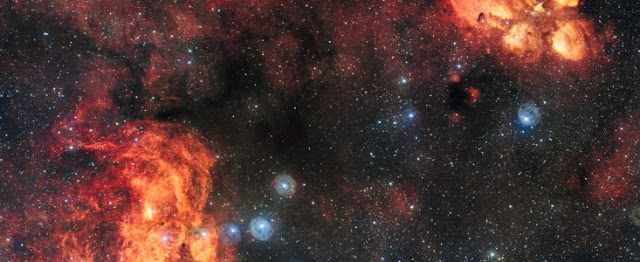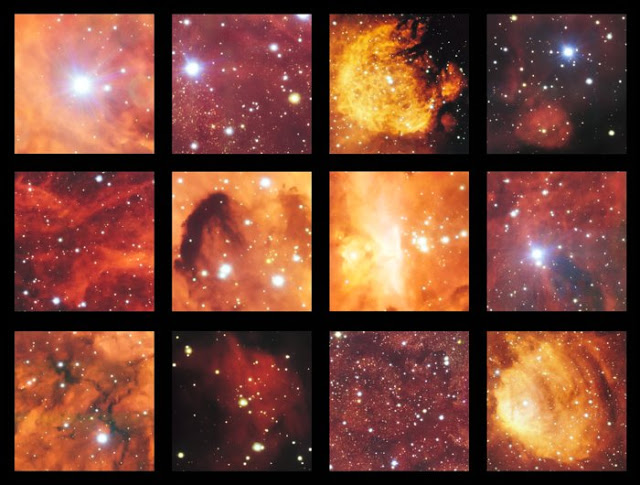

| Online: | |
| Visits: | |
| Stories: |

| Story Views | |
| Now: | |
| Last Hour: | |
| Last 24 Hours: | |
| Total: | |
Celestial Cat Meets Cosmic Lobster
NGC 6334 is located about 5500 light-years away from Earth, while NGC 6357 is more remote, at a distance of 8000 light-years. Both are in the constellation of Scorpius (The Scorpion), near the tip of its stinging tail.
The British scientist John Herschel first saw traces of the two objects, on consecutive nights in June 1837, during his three-year expedition to the Cape of Good Hope in South Africa. At the time, the limited telescopic power available to Herschel, who was observing visually, only allowed him to document the brightest “toepad” of the Cat’s Paw Nebula.
It was to be many decades before the true shapes of the nebulae became apparent in photographs — and their popular names coined.This spectacular image from the VLT Survey Telescope shows the Cat’s Paw Nebula (NGC 6334, upper right) and the Lobster Nebula (NGC 6357, lower left). These dramatic objects are regions of active star formation where the hot young stars are causing the surrounding hydrogen gas to glow red. The very rich field of view also includes dark clouds of dust. With around two billion pixels this is one of the largest images ever released by ESO. A zoomable version of this giant image is available here.
This video sequence takes a close look at a spectacular image from the VLT Survey Telescope. It shows the Cat’s Paw Nebula (NGC 6334) and the Lobster Nebula (NGC 6357). These are regions of active star formation where the hot young stars are causing the surrounding hydrogen gas to glow red. The very rich field of view also includes dark clouds of dust.
Credit: ESO/N. Bartmann. Music credit: Johan B. Monell
This montage shows a few of the highlights from a spectacular image from the VLT Survey Telescope showing the Cat’s Paw Nebula (NGC 6334) and the Lobster Nebula (NGC 6357). This part of the sky contains active regions of star formation where hot young stars make their surrounding clouds of hydrogen glow with a characteristic red colour. There are also clouds of dark dust in this rich celestial landscape.
OmegaCAM is a successor to ESO’s celebrated Wide Field Imager (WFI), currently installed at the MPG/ESO 2.2-metre telescope on La Silla. The WFI was used to photograph the Cat’s Paw Nebula in 2010, also in visible light but with a filter that allowed the glow of hydrogen to shine through more clearly (eso1003). Meanwhile, ESO’s Very Large Telescope has taken a deep look into the Lobster Nebula, capturing the many hot, bright stars that influence the object’s colour and shape (eso1226).
Despite the cutting-edge instruments used to observe these phenomena, the dust in these nebulae is so thick that much of their content remains hidden to us. The Cat’s Paw Nebula is one of the most active stellar nurseries in the night sky, nurturing thousands of young, hot stars whose visible light is unable to reach us. However, by observing at infrared wavelengths, telescopes such as ESO’s VISTA can peer through the dust and reveal the star formation activity within.
A new image from ESO’s VLT Survey Telescope gives a very detailed view of the star formation regions NGC 6334 and NGC 6357, often called the Cat’s Paw Nebula and the Lobster Nebula, respectively, because of their distinctive shapes. This ESOcast Light takes a quick look at this spectacular vista and explains what it shows.
Viewing nebulae in different wavelengths (colours) of light gives rise to different visual comparisons on the part of human observers. When seen in longer wavelength infrared light, for example, one portion of NGC 6357 resembles a dove, and the other a skull; it has therefore acquired the additional name of the War and Peace Nebula.
Contacts and sources:
Richard Hook
ESO
Source:




